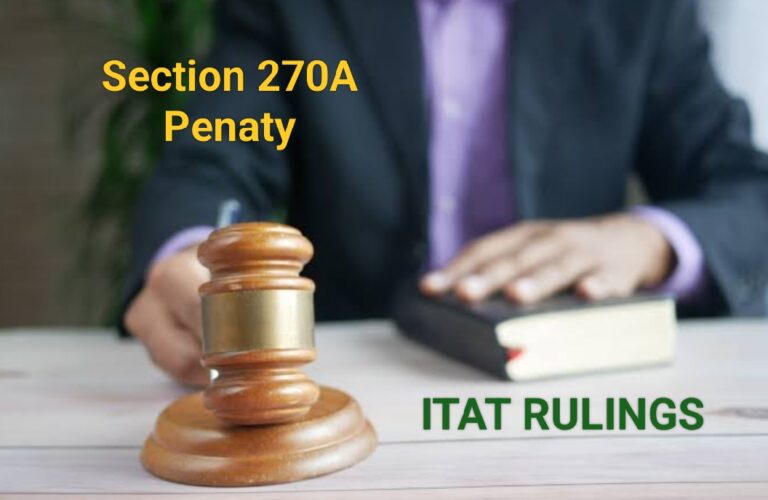Section 270A of the Income-tax Act, 1961, introduced with effect from Assessment Year 2017-18, aims to penalize cases of under-reporting and misreporting of income. It replaced the older Section 271(1)(c), streamlining the penalty mechanism with fixed rates and detailed categorization. However, despite its clarity in structure, implementation has witnessed significant judicial scrutiny, particularly when procedural defects or lack of evidence of deliberate intent are involved.
In recent years, Commissioners of Income Tax (Appeals) [CIT(A)] have played a crucial role in upholding taxpayer rights by dropping penalty orders under Section 270A in cases where the Assessing Officer (AO) failed to follow due process—especially in serving vague notices, failing to distinguish between under-reporting and misreporting, or ignoring bona fide explanations.
This trend has also been echoed by various benches of the Income Tax Appellate Tribunal (ITAT), reinforcing the principle that penalty provisions must be construed strictly, and taxpayers should not be penalized where there is no deliberate concealment or malfeasance.
This article discusses several recent rulings where CIT(A) or ITAT quashed Section 270A penalties, and highlights key legal principles and procedural safeguards that taxpayers can rely upon.
Here are several recent and noteworthy decisions where the ITAT dropped penalties under Section 270A of the Income-Tax Act:
⚖️ 1. DCIT vs Chakrahar Contractors (Pune ITAT – 26 Dec 2024)
The AO’s notice failed to specify the exact “limb” of Section 270A being invoked. CIT(A) and subsequently the ITAT held this to be a fatal legal defect, resulting in the penalty being quashed.
2. Melekandy Puthalath Farook (Chennai ITAT – Dec 2024)
A ₹54 lakh penalty under Section 274 read with 270A was deleted because the show-cause notice didn’t specify which sub-clause of 270A was in play—rendering the notice invalid.
3. Mono Steel (Ahmedabad ITAT – Feb 14 2025)
Here, the penalty was dismissed ex‑parte by the CIT(A) without considering quantum‑related relief. The Tribunal remitted the case for fresh grounds-of-reply, emphasizing the need to incorporate quantum disposal into penalty adjudication.
4. Cornerstone OnDemand (Mumbai ITAT – 2024)
Applying the “exception for bona fide explanation” under Section 270A(6)(a), the ITAT found no malafide intent and deleted penalties across three years (AY 2017-18, 2018-19 & 2019-20).
5. Sushil Rajendra Kothari (Mumbai ITAT – Nov 2024)
The notice didn’t clarify whether penalty was under-reporting (sub‑secs 1–6) or misreporting (sub‑secs 8–9). Penalty was held invalid for vagueness and thrown out.
6. ACIT vs Man Mohan Krishna (Jaipur ITAT – 2024)
The CIT(A) and ITAT both held the show‑cause notice vague since the AO invoked section 270A(8) without specifying the relevant limb. In absence of precise coverage, the penalty order was quashed.
7. Disallowance-Based Estimation Cases (Chennai ITAT)
When disallowances were based on estimates or misplaced vouchers, the Tribunal accepted taxpayers’ bona fide explanations. Under Section 270A(6)(a), these were deemed approachably genuine, leading to penalties being dropped.
🔍 Key Takeaways
- Notice Must Be Legally Sound
• Must clearly pinpoint which sub-clause of 270A is alleged—either under-reporting (s. 1–6) or misreporting (s. 8–9).
• Vague or generic notices often lead to the penalty’s quashing. - Bona Fide Explanation Exception (S. 270A(6)(a))
• If the taxpayer shows that additions/arbitrary disallowances are genuine and good faith–based, courts often waive penalties. - Triad of Penalty, Quantum & Natural Justice
• Ex-parte penalty dismissals that ignore quantum-order relief violate principles of natural justice. Courts often remit cases back to CIT(A) for full reconsideration.
📚 Case Summary Table
| Case & Bench | Key Issue | Outcome |
|---|---|---|
| Chakrahar Contractors (Pune ITAT) | Notice lacked clause specificity | Penalty quashed |
| Melekandy Farook (Chennai) | Ambiguous notice under 270A(9) | ₹54L penalty deleted |
| Mono Steel (Ahmedabad ITAT) | Quantum relief not considered | Referred back for fresh hearing |
| Cornerstone (Mumbai ITAT) | Bona fide case proven | Penalty dropped |
| Kothari (Mumbai ITAT) | Notice unclear on sub-section | Penalty invalid |
| Man Mohan Krishna (Jaipur ITAT) | No specification in penalty notice | Penalty quashed |
| Chennai Estimation Cases | Explained estimation honestly | Penalties removed |
✅ Practical Advice
- Check the Show-Cause Notice: Does it clearly specify the sub-section of 270A invoked?
- Document Clarifications: Especially on expense estimation or allocation—these can be vital under the “bona fide” exception.
- Ensure Quantum & Penalty Coordination: Appeals quoting quantum relief should reflect this in penalty arguments.
-
Enforce Right to Hearing: Ex-parte dismissals due to procedural failures can be challenged.
